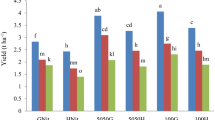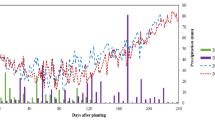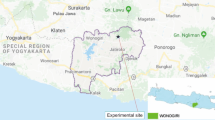Abstract
Alternate wetting and drying irrigation (AWDI) is a water-conserving strategy in rice fields. An experiment, conducted as a split-split plot design and based on a randomized complete block design with three repetitions, investigated the effect of intermittent irrigation and nitrogen on yield and water-use efficiency during 2017 and 2018 crop years in northern Iran. The irrigation intervals (flooding (I1), 7 days (I2), 14 days (I3)) were main factors, different levels of nitrogen fertilizer (50 kg/ha (N1), 75 kg/ha (N2), 100 kg/ha (N3)) were sub-factors, and cultivars (Gilaneh (C1) and Hashemi (C2)) were sub-sub-factors. Results showed that compared to flood irrigation, intermittent irrigation led to 16 to 43% and 13 to 43% water economization in 2017 and 2018, respectively, accompanied by a significant increase in water-use efficiency. By increasing the irrigation intervals, grain yield of the Gilaneh cultivar decreased significantly in all three fertilization levels. Compared to flood irrigation, total dry matter reduced significantly by increasing the irrigation interval. Maximum grain yield, total dry matter, and harvest index were achieved for the 100 kg/ha nitrogen fertilizer treatment in I1, I2, and I3 levels. Intermittent irrigation reduced leaf relative water content and increased leaf proline content in both cultivars. Leaf relative water content (R = 0.89**) showed the highest correlation coefficient with grain yield. The Hashemi cultivar showed higher leaf relative water content and leaf proline content and, while achieving 16.61% and 13.94% water conservation in the I2 treatment in 2017 and 2018, respectively, resulted in a yield equivalent to flood irrigation.
Zusammenfassung
Die intermittierende Bewässerung (alternate wetting and drying irrigation, AWDI) ist eine wassersparende Strategie in Reisfeldern. Ein Experiment, das als Split-Split-Plot-Design durchgeführt wurde und auf einem randomisierten vollständigen Blockdesign mit drei Wiederholungen basiert, untersuchte die Wirkung von intermittierender Bewässerung und Stickstoff auf den Ertrag und die Wassernutzungseffizienz in den Erntejahren 2017 und 2018 im nördlichen Iran. Die Bewässerungsintervalle (Überflutung (I1), 7 Tage (I2), 14 Tage (I3)) waren Hauptfaktoren, verschiedene Stickstoffdüngermengen (50 kg/ha (N1), 75 kg/ha (N2), 100 kg/ha (N3)) waren Subfaktoren und die Kultursorten (Gilaneh (C1) und Hashemi (C2)) waren Sub-Subfaktoren. Die Ergebnisse zeigten, dass die intermittierende Bewässerung im Vergleich zur Flutbewässerung zu einer Wassereinsparung von 16 bis 43 % bzw. 13 bis 43 % in den Jahren 2017 und 2018 führte, begleitet von einer signifikanten Steigerung der Wassernutzungseffizienz. Durch die Erhöhung der Bewässerungsintervalle sank der Kornertrag der Sorte Gilaneh in allen drei Düngungsstufen signifikant. Im Vergleich zur Flutbewässerung verringerte sich die Gesamttrockenmasse durch die Erhöhung des Bewässerungsintervalls signifikant. Der maximale Kornertrag, die Gesamttrockenmasse und der Ernte-Index wurden bei der Behandlung mit 100 kg/ha Stickstoffdünger in den Stufen I1, I2 und I3 erreicht. Die intermittierende Bewässerung reduzierte den relativen Wassergehalt der Blätter und erhöhte den Prolingehalt der Blätter in beiden Sorten. Der relative Wassergehalt der Blätter (R = 0,89**) zeigte den höchsten Korrelationskoeffizienten mit dem Kornertrag. Die Sorte Hashemi zeigte einen höheren relativen Blatt-Wasser-Gehalt und einen höheren Blatt-Prolin-Gehalt und erreichte bei der I2-Behandlung in den Jahren 2017 und 2018 eine Wassereinsparung von 16,61 % bzw. 13,94 %, was zu einem Ertrag führte, der der Flutbewässerung entsprach.

Similar content being viewed by others
Change history
31 August 2021
The correct affiliation 1 is: Department of Agronomy and Plant Breeding, Lahijan branch, Islamic Azad University, Lahijan, Iran
References
Ashouri M (2014) Water use efficiency, irrigation management and nitrogen utilization in rice production in the north of Iran. Apcbee Proc 8:70–74
Bates LS, Waldren RP, Teare ID (1973) Rapid determination of free proline for water-stress studies. J Plant Soil 39:205–207
Blum A (2005) Drought resistance, water-use efficiency, and yield potential are they compatible, dissonant, or mutually exclusive? Aust J Agric Res 56:1159–1168
Bouman BAM, Tuong TP (2001) Field water management to save water and increase its productivity in irrigated lowland rice. Agric Water Manag 49:11–30
Carrijo DR, Lundy ME, Linquist BA (2017) Rice yields and water use under alternate wetting and drying irrigation: a meta-analysis. Field Crop Res 203:173–180
Dasgupta PD, Bhabani S, Soumitra KS (2015) Soil water potential and recoverable water stress in drought tolerant and susceptible rice varieties. Agric Water Manag 152:110–118
Evans J (1989) Photosynthesis and nitrogen relationships in leaves of C3 plants. Oecologia 78:9–19
Haefele S, Kato Y, Singh S (2016) Climate ready rice: augmenting drought tolerance with best management practices. Field Crop Res. https://doi.org/10.1016/J.FCR.2016.02.001
Islam MSM, Gaihre YK, Biswas JC, Jahanc MDS, Singh U, Adhikary SKM, Satter A, Saleque MA (2018) Different nitrogen rates and methods of application for dry season rice cultivation with alternate wetting and drying irrigation: fate of nitrogen and grain yield. Agric Water Manag 196:144–153
Khush GS (2005) What it will take to feed 5.0 billion rice consumers in 2030. Plant Mol Biol 59:1–6
Kunjammal P, Lokanadhan S, Murali Krishnasamy S, Jawahar D, Ganesamurthy K (2020) Effect of rice varieties on physiological parameters under flood irrigation and alternate wetting and drying (AWD) irrigation practices. J Pharmacogn Phytochem 9(3):2197–2201
Lampayan RM, Rejesus RM, Singleton GR, Bouman BAM (2015) Adoption and economics of alternate wetting and drying water management for irrigated lowland rice. Field Crop Res 170:95–108
Liu L, Chen T, Wang Z, Zhang H, Yang J, Zhang J (2013) Combination of site-specific nitrogen management and alternate wetting and drying irrigation increases grain yield and nitrogen and water use efficiency in super rice. Field Crop Res 154:226–235
Niang A, Becker M, Ewert F, Dieng I, Gaiserb T, Tanakaac A, Senthilkumard K, Rodenburgd J, Johnsona JM, Akakpoe C, Segdaf Z, Gbakatchetcheg H, Jaitehh F, Bami RK, Dogbej W, Keitak S, Kamissokol N, Mossim IM, Saitoa K (2017) Variability and determinants of yields in rice reduction systems of West Africa. Field Crop Res 207:1–12
Peng S, Buresh RJ, Huang J, Zhong X, Zou Y, Yang J, Wang G, Liu Y, Tang Q, Cui K, Zhang F, Dobermann A (2010) Improving nitrogen fertilization in rice bysite-specific N management. Agron Sustain Dev 30:649–656
Rahman RMD, Bulbul SH (2014) Effect of alternate wetting and drying (AWD) irrigation for Boro rice cultivation in Bangladesh Agriculture. For Fish 3(2):86–92
Rashid MM, Jahan M, Islam KS (2016) Impact of nitrogen, phosphorus and potassium on brown planthopper and tolerance of its host rice plants. Rice Sci 23(3):119–131
Razaei M, Shokri Vahed H, Amiri E, Motomed MK, Azarpour E (2009) The effects on irrigation and nitrogen management on yield and water productivity of rice. World Appl Sci J 8:203–210
Song T, Xu F, Yuan W, Chen M, Hu Q, Tian Y, Zhang J, Xu W (2019) Combining alternate wetting and drying irrigation with reduced phosphorus fertilizer application reduces water use and promotes phosphorus use efficiency without yield loss in rice plants. Agric Water Manag 223:1–12
Sureshkumar R, Pandian BJ (2017) Assessment of physiological effects of rice under different methods of transplanting and irrigation management practices chemical science review and letters. Chem Sci Rev Lett 6(22):1321–1326
Tan X, Shao D, Liu H, Yang F, **ao C, Yang H (2013) Effects of alternate wetting and drying irrigation on percolation and nitrogen leaching in paddy fields Paddy. Water Environ 11:381–395
Wang Z, Zhang W, Beebout SS, Zhang H, Liu L, Yang J, Zhang J (2016) Grain yield, water and nitrogen use efficiencies of rice as influenced by irrigation regimes and their interaction with nitrogen rates. Field Crop Res 193:54–69
Wheatherley PE (1973) Studies in the water relations of cotton plants. The field measurement of water deficit in leaves. New Phytol 49:81–87
Yao F, Huang J, Cui K, Nie L, **ang J, Liu X, Wu W, Chen M, Peng S (2012) Agronomic performance of high-yielding rice variety grown under alternate wetting and drying irrigation. Field Crop Res 126:16–22
Ye Y, Liang X, Chen Y, Liu J, Gu J, Guo R, Li L (2013) Alternate wetting and drying irrigation and controlled-release nitrogen fertilizer in late-season rice. Effects on dry matter accumulation, yield, water and nitrogen use. Field Crop Res 144:212–224
Zhong C, Cao X, Hu J, Zhu L, Zhang J, Huang J, ** Q (2017) Nitrogen metabolism in adaptation of photosynthesis to water stress in rice grown under different nitrogen levels. Front Plant Sci 8(1079):1–15
Author information
Authors and Affiliations
Corresponding author
Ethics declarations
Conflict of interest
S. Eisapour Nakhjiri, M. Ashouri, S.M. Sadeghi, N. Mohammadin Roshan and M. Rezaei declare that they have no competing interests.
Rights and permissions
About this article
Cite this article
Eisapour Nakhjiri, S., Ashouri, M., Sadeghi, S.M. et al. The Effect of Irrigation Management and Nitrogen Fertilizer On Grain Yield and Water-use Efficiency of Rice Cultivars in Northern Iran. Gesunde Pflanzen 73, 359–366 (2021). https://doi.org/10.1007/s10343-021-00562-6
Received:
Accepted:
Published:
Issue Date:
DOI: https://doi.org/10.1007/s10343-021-00562-6




